|
FAQs about Stony Coral Health/Disease:
Predators, Pests
Related Articles: Coral Pests and Disease; pests, predators,
diseases and conditions by Sara Mavinkurve,
Quarantine of Corals
and Invertebrates, LPS
Corals, True or Stony Corals, Order
Scleractinia, Propagation for Marine
Aquarium Use,
Related FAQs: Stony Coral Disease 1, Stony Coral Disease 2, Stony Coral Disease 3, Stony Coral Disease 4, Stony Coral Disease 5, Stony Coral Disease 6, Stony Coral Disease 7, Stony Coral Disease 8, Stony Coral Disease 9, Stony Coral Disease 10,
Stony Coral Disease 11, Stony Coral Disease
12, Stony Coral Disease 13,
Stony Coral Disease 14,
FAQs on Stony Coral Disease by Category: Diagnosing:
Environmental (Pollution/Poisoning, Lighting...),
Nutritional, Social (Allelopathy),
Trauma,
Pathogenic (Infectious, Parasitic, Viral)
Treatments
FAQs on Stony Coral Disease by Family: Acroporid Disease, Acroporid Disease 2, Acroporid Disease 3, Acroporid Disease 4..., Caryophyllid Disease, Caryophyllid Disease 2..., Elegance Coral Disease/Pests, Dendrophylliid Disease, Faviid Disease, Faviid Disease 2, Fungiid Disease, Mussid Disease, Mussid Health 2, Poritid Health, Trachyphylliid Disease, Trachyphyllia Disease 2,
FAQs on Stony Coral Disease by Type: Brown Jelly Disease, RTN,
|
MANY players... crustaceans, worms, molluscs, much more
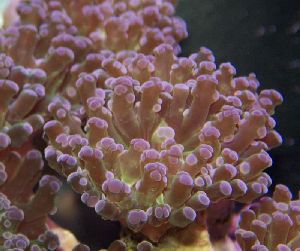
Removal strategy groups in order of preference:
Prevention through Quarantine
Biological
Trapping
Manual/Mechanical
Lastly: chemical
|
|
Black bugs from hell
10/19/16
Hi crew,
<Fahd>
Hope things are well with you all.
<Yes; thank you>
I'm hoping to get an I.d plus possibly some advice on treating these little
buggers (pun intended).
I have included some pictures that I took, you can see how small they are on
the rocks, and I was able to capture some and look at them under a
microscope at my university.
They run around quite fast on the rocks, in random patterns, especially when
a flashlight has been shone on them.
These bugs tend to target lps corals, and are leaving my sps alone. They
seem to hit one or two coral at a time, rather than to infect all of them at
once. For example I would see slow recession on one or two frags at a time.
<Mmm... infect? Nah... not even infest... >
Dipping frags in iodine had no effect. Dipping them in coral cleaner
"revive" had no effect.
After much reading online, I found out that the drug interceptor, with
active ingredient Melbemycine oxime seems to have worked for others in the
past with similar pests.
<Yes... this appears to be a copepod/ite... the single eye....>
One large tablet of interceptor is meant to treat 380 gallons. My aquarium
is roughly 85-95 gallons of water, therefore the first treatment consisted
of .25 of a full tablet. This had no affect on the bugs and they were still
running around on the live rock.
<Heeeee!>
Then I treated the aquarium (without water change or carbon to remove the
first treatment) with 1 full tablet, knowing that overdosing is not known to
cause any major issues. This yielded no ill effect on the bugs.
Finally, I got very annoyed and used all my remaining interceptor; 2.5
tablets, which came out to roughly 10x the suggested treatment strength.
This, finally, caused the bugs to seemingly die, as I no longer saw them
running around on the rock.
The affected lps also looked much puffier and happier after the final
treatment, with receding seeming to stop.
That was a week ago, and today I noticed that 2-3 bugs were running around
on the rocks again (compared to seeing about 20 on the same spot of rock
originally). I'm assuming that some eggs may have hatched or something.
These bugs have cost me a small fortune in coral frags
<Really? As in eating them?>
and treatment costs, and any advice with a possible i.d would be much
appreciated. Any thoughts on alternative treatment options?
<A few... I'd use a predator...>
Is interceptor my best bet at this point? It's bizarre that they need such a
strong treatment.
<Something/s absorbing the arthrocide here... Happens all too often...
Chemical filtrants, "bio mass"... detritus>
Thank you for your time, enjoy your day.
Fahd.
<Let's have you read here:
http://www.wetwebmedia.com/ca/volume_5/volume_5_2/copepods.htm
and the linked files at the bottom. Bob Fenner>
|
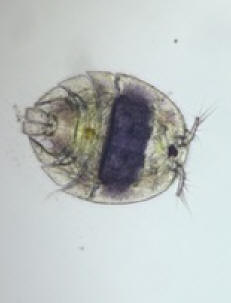
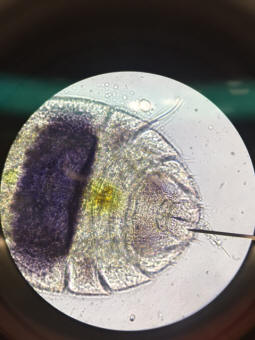
Re: Black bugs from hell.
10/20/16
Thanks, Bob. I saw your response and agree. Heeee - it's a cyclopepod!
Take care, Lynn
<Heeee! Thank you Lynn. BobF>
Re: Black bugs from hell.
10/26/16
Hi crew,
<Fahd>
This will be a long e-mail, and in my frustration, I might repeat myself, so I
apologize in advance.
<No worries; take your time>
Thank you for your reply concerning these black bugs that I'm dealing with.
It seems as if they simply refuse to go away, and I'm starting to renegotiate
whether or not they need to be eradicated or not due to the sheer cost/effort
it's taking to get rid of them.
<You are wise to consider all options; ongoing>
Firstly, this all started when I lost a few lps corals, slowly, and despite all
my efforts, they didn't recover and died. These were expensive/prized pieces
such as chalices, Scolymia corals, and Euphyllia torch corals. These corals were
all with me for longer than 1 year, and over that time, had grown substantially.
The torch corals sprouted 3 new heads, scolymia's grew visibly larger, etc.
I'm telling you this because at the time they started to recede, I found it very
odd that they would be visibly happy, and be growing in my tank, and then all of
a sudden show recession. This would happen almost one or two corals at a time...
first one of the Scolymia, then chalice, then the other Scolymia, etc. During
that time, I did lots of research on recession
of LPS corals, and I started to go down the list of possibilities.
Initially I kept thinking that it could have been my water quality, and tried to
make it as pristine as possible, tried to reduce Alk fluctuations the best I
could, etc. All the while, my other corals such as Zoanthids and SPS were doing
perfectly fine,
<Mmm; the Zoanthids... possibility of allelopathy. Was there a correlation twixt
nearness and time of death?>
which seemed odd to me. During my attempts to recover the receding scoly's, I
also blamed my lack of feeding the corals, but the thing that kept bothering me
was that if my water quality or lack of feeding them be the real culprit, why
have them start to recede now, after years of showing growth and signs of being
healthy. With nothing seemingly changed in my tank, these general answers just
didn't make any sense to me.
It was finally after a while that I stumbled upon threads mentioning little
"black bugs" slowly eating their lps, including chalices and Scolymia corals. It
seems to be best described in this thread here:
http://www.reefcentral.com/forums/showthread.php?t=1400291&page=6
Help Chalices are Melting Away. - Reef Central Online
...<http://www.reefcentral.com/forums/showthread.php?t=1400291&page=6>
www.reefcentral.com
Help Chalices are Melting Away. LPS Keepers ... Do you think there may have been
a shift in your alkalinity within this past month? 10 is ok, lil high for me,
but ...
Unfortunately, nobody has truly documented these black bugs under a microscope
in the thread, etc, so I can't make a positive I.D of the black bugs that I've
found in my aquarium, but reading and comparing the symptoms described in the
thread leads me to believe I might have the same issue.
After that, I spent a long time researching and reading about black bugs
eating/killing lps corals, and only after so much reading/researching did I
notice tiny black specs running around on my rocks. They run around, seemingly,
only on the purple, coralline spots on my rocks.
The only reason I'm e-mailing you again, is that now I'm almost at a loss, and
feeling very defeated. As described in my initial e-mail, I dosed 1x strength of
interceptor with no visual effects on the bugs running around on the rocks.
<Yes; I recall... and am more concerned re the Zoas... I would try the chemical
filtration route here (Chemipure, Polyfilter) in attempt to reverse the
recession... OR even move out the rock/Zoanthids to elsewhere>
I dosed 4x strength with no affect on the bugs, and finally, I did 10x the
strength of interceptor, which finally seemed to affect them, and I stopped
seeing them running around on the rocks. For about 5 days. Then I noticed
possibly 2-3 bugs on the rocks again (as opposed to 20-30). After 2 days, I did
a second treatment of 10x dosage, and again, for 4 days I saw nothing on the
rocks, until today, when I noticed about 4 more bugs on the rocks.
<Zounds!>
This is ridiculous, and I'm throwing in the towel with interceptor. It costs me
close to $100 every time I do a 10x dosage treatment, with medicine cost, water
change cost (my aquarium is around 100 gallons), etc.
I don't know what else to do,
<There are other Arthrocides, but I'd hold off for now>
I can't keep doing 10x dosages in my aquarium, because it has caused an algae
bloom of Cyano/hair algae (likely from change in water chemistry due to deaths
of pods, etc). I took all my clean up crew out, as the 10x dosage was effecting
even all my large (up to 3-4 big turbo snails) clean up crew, wiped out all my
hermits, which was ridiculous because after 36 hours of treatment, I hooked up
my protein skimmer back on, reattached my carbon reactor, did a 50% water
change, did another 50% water change, then finally added the hermits, and they
still died after 6 hours. This leads me to also
believe that the treatment truly WAS 10x the strength in my aquarium. but these
bugs from hell keep returning. Scientifically, this should be impossible!
Is it possible, that the bugs I see running around on the rocks, might be
different from the "bugs" or parasites which were eating my LPS?
<Mmm; yes; possible>
My evidence for this theory is, that since the first 10x treatment, the torch
and chalice coral which were currently receding have now stopped.
They both look much puffier and healthier, and are seemingly recovering from
their receding. At night time, I now see the chalice coral extending feeder
tentacles, whereas before (during recession) it wouldn't do that.
It's possible, that this is due to the bugs having dwindled in numbers, (because
I used to see about 20-30 on the rocks, whereas now I only see 3-5), so
currently the corals are unaffected.
<Evidence of "bug eating" evidently>
Or, the bugs I see on the rocks are different from the bugs who were eating my
LPS, and therefore I see a visible increase in the health of my LPS, even though
the bugs on the rocks haven't been completely eradicated (this is the theory my
mind has created using false hope, to keep me from going insane). Is there any
likelihood of the second (false hope) theory?
<There is of course (?) some likelihood of "other predation" here; but what?>
or am I just being completely irrational? and as long as I'm seeing these bugs
on my rocks, then eventually they'll migrate back into my corals and start their
all you can eat buffet?
<Can't tell; but too likely so>
I was really hoping, having looked at these things (that were running around on
my rocks) under a microscope, that I might be able to get an identification
somehow, and bring to light if these guys really are the culprit. If you did
identify them as copepod/ite, I don't understand how the interceptor almost
killed my snails (they were upside down, all of
them), and even after all those water changes + carbon, still eradicated my
hermit crabs, but failed to annihilate these bugs from hell.
<Some stage/s that Interceptor doesn't touch?>
I have a leopard wrasse, who constantly picks on my rocks so I believe he might
be responsible for keeping their numbers in check? but he could just as easily
also be picking on other things on my rocks.
<Likely does help>
At this time, I've decided, since I only have enough medicine for 1 more 10x
treatment, to just leave them be. I'm hoping (although knowing my luck I'm
99.9999% wrong) that the bugs/parasites which were bothering my LPS are
different from these bugs that I saw running around on my rocks, and that all
the interceptor treatments worked (thus improvement in health of receding LPS).
I'm going to let it run it's course for the next month, keeping an eye on the
chalice and torch corals, and hopefully the real problem has already been
eradicated by interceptor so far.
Once again, I apologize for the sheer volume in this e-mail, I just wanted to
explain my situation in complete. Any thoughts and advice is much
appreciated.
Enjoy your day,
Fahd.
<There are some other approaches... drastic to less so. Removing all desired
biota, dipping (a few poss. here) and placing elsewhere, when all out,
bleaching/nuking the system... re-setting up.... TO just adding more purposeful
"bug" eaters (Paracheilinus, Pseudocheilinus wrasses are faves).... What will
you do? Bob Fenner>
|
|
Coral Beauty... 16.5 megs of non-descript pix, no data, or
reading... Full moon?
12/11/14
Hi There, I had a couple of corals that looked like these
pictures.
<... they're dead, dying... evidently you have a "water quality
issue" or three... Too much nutrient, BGA et al. overgrowing... But, you
supply no data re>
The base of the frag would suddenly be white then it went up one side.
<Yes; bleached... dead>
When I was looking closely I could see some loose tissue thought it was
tissue necrosis. It seemed to occur only at night so I was thinking
sudden parameter change but nothing had changed. Then I thought maybe
flat worms.
so I purchased a six line wrasse. Well I was looking at a coral that did
not have any missing tissue and then I was looking at the tank and
suddenly there was some tissue missing one side by the base. Set back
and watched the Coral Beauty suddenly nip on the same side as the
missing tissue.
<Sometimes most Centropyges do nip Cnidarians>
I seen him nip at it a few times and the whole side of the frag had been
nipped clean. Now I have to get him out before he destroys all the
accros.
Know of any good ways other than taking most of the rock structure out.
<Yes; search WWM re... all gone over and over re traps, netting
techniques>
Not going to be fun as it is a 250 gallon tank. I will never put another
fish in the tank that maybe questionable as being reef safe.
Thanks Bruce
<Read WWM's requirements re writing us please. Bob
Fenner>
|
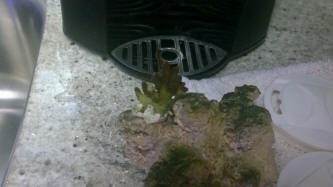
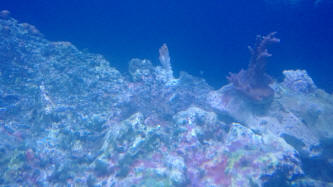 |
|
Re: Coral Beauty
12/12/14
Hi Bob,
Bruce Here
<Heya>
Sorry about the size of the photos, did not realize the size of them from my
cell phone.
I believe you answered my question on the corals and even the fact that the
Coral Beauty Angel is picking when it was not before.
<Ahh!>
Data for tank
250 gallon display tank 72 x 26 x 30, 125 gallon sump, over flows at both ends
of display tank, two Aqua C, EV-240 skimmers at each end of sump. About 200
pounds of rock from previous tank plus one large flat piece to seed old rock.
There is total water volume of 300 gallons in system. Tank has gone thru cycle
all hair algae and cyno is gone. Only have thin hard green algae growing in
places and some purple coralline growing on bottom and a few rocks. Fish in tank
Kole Tang, Two Yellow Tangs, Tomini Tang, Coral Beauty, Dart fire fish, six line
wrasse.
Lighting is by 2 Orphek Atlantiks, using led is new to me. Granulated carbon
reactor, gfo reactor, biopellet reactor
S.G. 1.025 digital refractometer
PH 8.32
Temp 79.8 morning 81.2 nights
Calcium 420
Alkalinity 8.74 dKH
magnesium 1480
Phosphate .07
Nitrates are a bit high around 50
<Yeeikes; this is much more than a bit... s/b under 10 ppm for a reef>
Biopellet reactor added about 2 weeks ago.
<Do you have a carbon deficiency?>
Moved lights up about 6 inches as the spread was not enough and at the same time
the program was changed to less light. I think the lighting is the problem as
some of the corals started turning brown.
<Mmmm; can you move them up on the rock, closer to the light?>
I have had 4 corals that this has happened to and 2 of them so far are surviving
and look like they may be getting back some color and growing. To many changes
on an immature tank and coral stress.
<Yes, too. Review Scleractinian care on WWM please. BobF> |
Coral pest worm 11/8/2009
WWM crew,
<Scott>
55 gallon tank with hang on back refugium that contains a RDSB all
levels calcium nitrate etc are at optimal levels, way too much live
rock, not sure how much (rock taken from former 100 gallon tank at last
residence, new place to small for something so big sadly had to get rid
of the livestock that wouldn't do in a smaller tank) I do a 5
gallon water change every 2 weeks and use a 2 part supplement to
maintain calcium/alk also add iodide to the water. 2 150 watt metal
halide lights 2 HO fluorescent lights.
needle wheel impeller style skimmer. the tank has been up and running
here for only about 3 1/2 months but all the rock and when I changed it
over the water from the old tank that was running for about a year was
used in the new tank, didn't experience any new tank affects when I
did this. I have 2 false percula clowns 2 green chromis and 1 cleaner
shrimp, a mixture of LPS, SPS corals, SPS is all very close to the
surface to ensure they get enough light.
This morning I noticed that part of my candy cane coral seemed to be
missing. on the inner part of the polyp where it is green instead of
the reddish brown area. I just fed this coral yesterday and did not
notice this yesterday. I fed the coral some formula one marine pellet
that I discovered my LPS corals have a feeding response to in addition
to the
mysis shrimp I had been using. Any ways on further inspection I found
what seemed to be some type of worm the worms are white and skinny, I
attempted to remove the worm with a pipette using suction. when I did
this I noticed many more around the same area, I took the coral out of
the water and attempted to get the worms off, I moved the coral to the
refugium. I purchased the coral about a month ago. the corals health I
thought looked improved after I started feeding it, doubt it was being
fed by the last owner.
Anyways I want to ask the following, is there any dip/bath you would
recommend giving this coral to remove the parasites,
<Mmm, not parasites... predators possibly... but much more likely
these are just feeding opportunistically (if at all) of the coral
here...>
is there danger of these worms infesting other corals, if so should I
treat every coral in my tank? This is my first experience with any
coral disease/pest and I am unsure what to do a search on the internet
did not provide much help. as my main display tank I left bare bottom
to ensure easy cleaning I do not think a wrasse which I found suggested
being used would be a good addition to my tank, besides the last fish I
wanted to add was a mandarin dragonet as soon as my tank is old enough.
I know they do better in bigger tanks but with the tank having so much
liverock it almost reaches the surface and the addition of the refugium
I am hoping will be good enough for it, I definitely have enough pods
in the tank currently. I do not want to overstock so I would prefer not
to use any biological controls. For some reason my camera is messing up
as far as transferring the pictures to the computer to send out,
another problem to deal with great, so hopefully my description will be
enough. I do not think a picture would add much the pests seem to be
thin white worms between about 2-3cm long very thin, in the picture I
took you could barely see them.
Thank you in advance for all of your help, I have found your website to
provide the best information on the hobby and it has been a great help
in my reefkeeping addiction.
<... I wouldn't over-react here. There are many species of
worms... the vast majority of which are more help than harm. I suspect
this Faviid had some trouble a month back when you bought it... I would
maybe step up your iodide/ate dosing, but otherwise just ignore these
worms. Bob Fenner>
|
Foraminiferans Irritating Corals?
11/21/2008 Hello to whomever is answering emails today
:D <Hi Miguel, Mich here.> I've been having an issue
with what I think are Marginopora vertebralis, which I just
Id'd thanks to the handy search function on your site.
<Looks to be so.> For a back story, I've had issues
in the last few months with LPS peeling slowly, and every time
on the peeling flesh I find these Foraminiferans. It seems like
they're slowly irritating the corals to death as they feed
on whatever it is that they're feeding on the live rock.
<Mmm, does not necessarily make it causational.> I've
included a picture of what I think is them irritating a coral.
<In researching I have not found information to support
this, but that does not mean it is not possible.> This is
how all of the peeling LPS tissue in my tank looks like, you
can see that at 12 and 6 o'clock they are digging into the
flesh of the coral, and especially at 5 o'clock you can see
a smaller one digging into the coral with a distinct peeling
flesh next to it. <This is unusual.> At the very bottom
right of the image you can see them working into the flesh as
well, and in the top left there is a white spot on the coral
that's actually another one that has just attached. <I
see.> I'm not sure if these are the cause of the problem
or just bystanders in another tank issue that may be going on,
but it's a bit coincidental that they're always right
at the edges of the peeling sides of the corals. <Some types
of Foraminiferans feed on bacteria, perhaps the Foraminiferans
are feeding on areas of decay.> One of my friends had a
microscope, so I'm attaching several highly magnified
images in order of magnification. <Cool!> They average
about 1mm across, and in picture 4 there is a blob of green.
<I see.> I'm not sure what that is but it's the
only block in the Foraminiferan that had one in there, possibly
it's feeding on it? <Is a possibility.> Thanks very
much for your time, and I hope things are well! <Thank you
Miguel.> Miguel <Cheers, Mich>
|
|
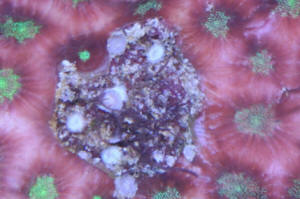
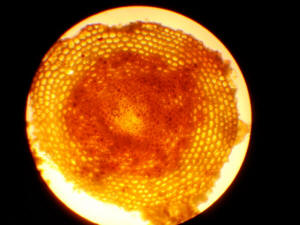
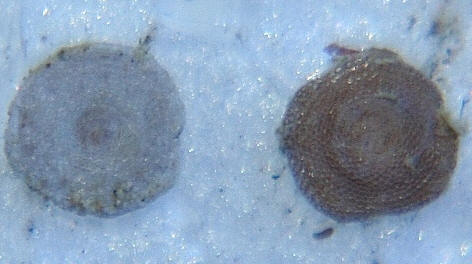 Nice pix! RMF Nice pix! RMF
|
| Snail eating coral? Possibly. Remove? Definitely!
2/3/08 Hello Crew, <Hi there!> I recently purchased an
order of hard/ soft corals from GARF and have found two snails on
what I believe to be Seriatopora guttatus or Stylophora pistillata.
<Uh oh.> I broke the snails free and the coral was completely
bleached underneath. <Ouch!> I'm assuming that this is
just because they stayed there for such a long time. <Could
be.> There is no trail of bleaching leading me to think that the
snail is feeding on the coral, but I have never seen a type of
snail that stays on a coral so long as to bleach it. Any input?
<Yep, any snail that damages a coral like that has to go! After
looking at the photos, I can tell you that it's not Drupella
cornus, a snail species with a taste for the two corals you
mentioned, plus others. Unfortunately, there are many other
coral-eating snails, and I can't quite see enough detail in the
photos to tell if yours is one of them. As mentioned before,
I'd go the safe route and get rid of them.> And one more
semi-related question, when do you decide that a bleached coral
(Acropora sp.) no longer has a fighting chance? <When algae
starts growing on it. Take care. --Lynn> |
|
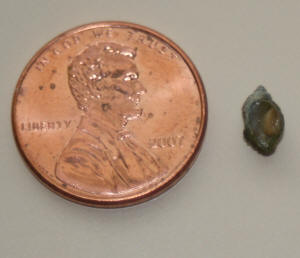 .JPG)
|
Candy cane/ torch coral loss, help please!
8/23/07 Hi Crew, I have a 37 gallon salt water reef tank. My
nitrates are in the o.k. range, and my filtration system is (2) 50
gallon aqua clear filters, lighting is coral life, 30in 130 watt
fixture, (1) T-5 30in 36 watt fixture, salinity perfect, 50 lbs of live
rock. I have torch coral that shrivels, falls apart, dies one head at a
time, (no brown slime). I also have been battling red algae (with
frequent water changes & rock cleaning) which seems to also be on
the stem of the torch coral. <These events may be related...> I
do maintain an arsenal of snails in the tank. How can I salvage what is
left of my torch coral?? <Break off the living heads, or the dead
ones... move the live part/s to another system> I also have candy
cane coral which appears to have some sort of pale yellow calcified
growths with one small tube protruding out per growth. The growth
surrounds the base of the heads and at this point I have lost 3. The
growth is starting to appear on the live rock at various points in the
tank. What should I do to save the rest of my coral and do I need to
eradicate the growth, and if so, how?? Thanks, JP <"Frag momma
frag, whatcha gonna do?" Need to discern what the real/root
cause/s of the trouble in this one system is/are... and fix...
"Small systems are hard to keep stable, optimized"... Perhaps
a cursory reading on WWM re toxic tanks will bring something live to
your consciousness. Bob Fenner>
|

|
| Frogspawn Infestation 11/6/05 Hello all,
<Howdy Matt> WWM is an excellent site with tons of info. I
could not find anything with my problem, however. I have a 45
gallon breeder aquarium with 285 watts of VHO light that is
dedicated to mostly LPS/softies. It has been set up for about 10
months, and most of the livestock is doing very well.
Beginning about 4 weeks ago, the frogspawn was not showing as much
polyp extension. There has been progressively less and less
extension since that time, so I looked very closely at it. There
are many tiny white creatures crawling all over it. From a
macroscopic perspective thy look like copepods: Same tiny size,
white color, and movement. I'm attaching a picture that shows
the relative small size of the critters, if not much definition.
<Nice pic> I also have other Euphyllia in the tank including
a torch coral, hammer coral, and pearl bubble coral. All these
corals are doing well and do not show any signs of infestation.
Tank parameters are kept stable with a top off unit and B-Ionic. I
run an aqua C urchin skimmer and do regular water changes. I have
not dipped new corals when I add them to the tank however, and feel
that this is the most likely source of the white critters. Other
measurements: Salinity 1.025 Nitrates 0 Ph 8.2-8.3 Ca 420 DKh 9.8 I
know I should start dipping new corals, but what can I do for the
current Frogspawn infestation? And what are these things?
Thanks, Matt <From the pic, your description of their behavior,
likely some sort of crustacean... I would go the fish predator
route here if you can allow, have space... Perhaps an Amblygobius
species of Goby... a small, compatible wrasse... Bob
Fenner> |
Myrionema pom-pom hydroids... yikes! 3/8/05
Good Day, I hope you stay very well. <indeed my friend... with hope
for you in kind> I've a big problem. A Myrionema amboiniensis on
my reef tank, with SPS and LPS. <ughh... can be miserable if your
nutrients are high. Very sorry to read of this challenge for you my
friend> I've checked on WWM, and on internet, but I didn't
find anything... How to eliminate? <its really all about nutrient
control. Back in the Berlin- style reef days (aggressive
skimming/nutrient export), we used to ADD this hydroid to our tanks for
its beauty. It never grew fast and sometimes died out. Nowadays,
aquarists that overfeed, overstock (big tangs in the tank) and have
generally weak protein skimming (less than 2-3 cups of skimmate weekly)
suffer from this animal> Julian Sprung say with "keyhole
limpet"... but... which keyhole limpet? <it varies... do a
message board search here, my friend. I've never used limpets for
this. Still... I'd rather see you treat the problem (nutrients) and
not the symptom (hydroids). Otherwise, when the hydroids are eaten, the
now available nutrients will simply feed some other exploding
population of nuisance organism (algae or pest anemone perhaps)>
Because here, in Italy, isn't easy to find such creatures... so
when I know the exact name I can search better. <ah, yes...
understood!> Other ways of? I've tried also mechanical methods,
but no result at all... They grows behind the rocks... <I think the
very best way is to improve your skimmer performance. Clean and tune it
to give you daily dark (coffee colored) skimmate> May you help me?
Thank you very much, and thank you for your WetWebMedia site, it's
fantastic! Danilo Ronchi, Rimini Italy <ciao, caro Danilo. Anthony
:) >
Vermetid snails taking over - how to control 6/16/04 This
question is for Anthony Calfo if available. <in your service>
Anthony, I have a 75 Gallon reef with mostly SPS corals. It
is a mature tank with much of the rock/corals I have kept for over 5
years. <very nice> You mention in your book of
coral propagation that Vermetid snails are a "normal"
thing. <yes... inevitable in some quantity> For
some reason I have LOTS of these guys. I can live with
the stringy stuff they give off but some of them are a real problem.
They seem to like to grow on my Montipora (Cap and Digitata). They do
not seem to bother the Acropora as bad. In fact, I
have one that has planted itself on the back of a large purple rimmed
Cap I got from a friend. I also had one climbing up a green digitata
and in my opinion has "choked" it out. Can I do anything to
control these critters and why do they like growing on my corals?
Thanks for the help. Andrew <as you might guess, they are not
growing from thin air - or water as it were - but rather, they are
filter feeders that are flourishing because of excess nutrients. Better
nutrient export (or limiting import) will easy check these creatures
and force them to wane. If skimmer performance has waned (less than
several dark cups of skimmate weekly minimum), or if the water change
schedule has been too modest/small all along and caught up with you
(20% per month or less), or if feeding habits are sloppy like mine
<G> like thawing frozen foods but not decanting the thawed pack
juice which is "rocket fuel" for growing nuisance algae,
sponges or Vermetids in this case. Some possibilities to consider. But
I can reassure you my friend... control the nutrients and you will
control their growth. There is no "reef safe predator" on
these snails for the aquarium. Anthony>
Will mantis shrimps or bristle worms in any way damage corals or
clams? 6/15/03 <Hello, PF with you tonight> Will mantis
shrimps or bristle worms in any way damage corals or clams? <Ok,
I'll break this down: Mantis shrimp will generally not harm corals,
unless they disturb them by walking across them. Depending on the
relative size of the clam and the mantis, and the type of mantis
(smasher vs. spearer), it could kill and eat a clam. A 2" mantis
is no threat to a 10" clam, a 6" mantis is another story.
Bristle worms: in general, no. If they are in plague numbers, they
could irritate a corals tissue. As for clams, they have a bad, and
undeserved rep. Often a clam with be doing poorly, but still look
healthy overall. The clam dies overnight and the worms come out and eat
it, the nest morning the aquarist sees the worm shell crawling with
worms and makes the obvious (but wrong) conclusion. There are a few
species of worms that prey on clams, but they are very rare in
captivity. Bear in mind these are generalizations, you can get a more
specific answer with a more specific question. So on that note, have a
good evening, PF>
Coral parasite control 4/2/03 My partner has a coral reef
aquarium but is away for 3 months and has asked me to take care of the
aquarium in his absence. I don't really know anything about
aquariums and just do the basic stuff like feeding,
etc. I'm having problems with one of the corals (shaped
like a mushroom - sorry don't know what it's
called). It's seems to be getting parasites on a very
regular basis. I know that my partner normally removes these
himself very carefully, which is what I've been doing, however,
they keep appearing. Is there any way of preventing these parasites
from appearing? <there are natural predators likely for these
parasites... perhaps a wrasse species. But we must first identify the
specific parasite (flatworm, etc) before we can find the compatible
predator. Even then, a new fish would have to stay in quarantine for 4
weeks before being added to the tank for fear of introducing a
contagious fish parasite to the established fishes. There is no fast
solution unfortunately. Please keep removing them manually until your
partner returns to make a long term decision on a natural predator.
Best regards, Anthony>
Coral Eating Flatworms and need for QT 3/25/03 Dear WWM crew-
<cheers, mate> For the last year my Acropora sp. corals have been
ravaged by coral eating flatworms (see picture in Julian Sprung's
Invertebrates book or The Modern Coral Reef Aquarium).
<yes... quite familiar with it. It is an aquarists penitence for not
properly using a QT tank for all new livestock. Its a dreadful lesson
to learn the hard way. Please be sure to QT all (algae, plants, fish,
live rock, coral... everything) for a simple 4 weeks first. There are
several very good articles here on WWM for guidance on the topic from
Fellman> I first noticed that areas of my corals were bleaching
usually underneath in low flow areas. Upon closer inspection
I noted masses of <1 mm golden brown eggs next to the areas of
bleaching. The worms themselves are cream colored and blend
in with the coral quite well. In their wake they leave a
pock-marked appearance to the tissue of the coral and eventual
bleaching. My control methods so far have been to scrub the
eggs off (although they can be in rather inaccessible areas) and blast
the corals with a powerhead so that the worms come off. This
seems to work better after the coral has been taken out of the water
for 2-3 min. By the way, my Anthias have learned to love
eating the flatworms and don't usually miss a single one.
<yes... but labor intensive especially for a pest that has direct
development (on its prey)> My question is do you know of any other
method of control or better eradication? <nothing
surefire... although many have been suggested. Anampses sp. (delicate)
perhaps, but only if your tank is large (over 100 gallons), peaceful
(fishes), mature (over 1 year old) and preferably with a fishless
refugium to support it. These "Tamarin" wrasses have thick
rasping lips... advantage over other wrasses> The worms seem to
prefer my Acropora valida type corals (aka
"tricolor"). They recover after my removal method
but within 1 month are back in the same
situation. Halichoeres wrasses seem to ignore the worms
(hard to see) and I can't imagine that a Nudibranch would climb on
to a coral to get them. Know anything about "Flatworm
Exit"? <"Coming to a Theater Near
You!"> Thanks, John Boe <best of luck, John. Anthony
Pocillopora Problem? Hello, <Hi there! Scott F. with you
today!> I bought a frag identified as Pocillopora damicornis from
ETropicals about 2 months ago. It was advertised as a green
Pocillopora, but when I received it, it was a pale brown color. <Not
uncommon when newly received...> I placed the coral approximately
5-6 inches from the water surface, and the tank receives light from 2x
96 watt compact fluorescents (1x 10000K and 1x
ultra-actinic). The coral has its polyps extended for the
majority of the photoperiod (about 12 hours a day), and sometimes keeps
its polyps extended well after the lights go off. <Good!> I was
initially worried about this coral, since I would see my Peppermint
shrimps seemingly grazing on this particular coral. It
almost looked like it was trying to pick at the polyps. I
have 4 (approx. 1 inch) Peppermint shrimps in my tank. I
read on your site that they may pick at corals, but usually not to harm
them (they're rather doing their job and cleaning stuff off of the
corals). <I'd get nervous seeing them around my Pocillopora,
too. They usually are harmless, but anything is possible, you know?>
I make sure that I put in some supplementary food that they are able to
eat, and they have been doing it much less. <Excellent. I wish I
could have said the same for my Sailfin Blenny, which constantly
snacked on my Pocillopora, until I relocated him!> Since being
placed in the tank (with moderate indirect, turbulent current, and full
exposure to the current light setup), the coral has slowly changed
color from the light brown to a fluorescent green. <Awesome!> I
figure this was a good sign, since it appears more now of what it was
initially described. However, I just noticed today that
there is a small patch (about 1 mm x 1mm)on of the branches of the
coral that seem to have lost tissue. It is not completely
white, and still has some brownish hue to it. The polyps in
that small area is either retracted or no longer
there. I'm worried that this could be the start of
something bad. Water parameters are: S.G. of 1.023-1.024,
Ammonia and nitrite is 0 and nitrate is 5-10 ppm. Calcium is
360-400, and pH varies from 8.3-8.6. The aquarium has a 3
inch live sand bed, and the aquarium is a 55 gallon bowfront with 30
lbs of live rock. The system is about a year and a half
old. I have been having problems with my lighting recently,
with the PC bulbs visibly (honestly) losing intensity in about 2 months
time. Could the coral tissue be receding because of
inadequate lighting intensity? <I suppose it's possible, but I
doubt it, in this case. sounds to me more like a localized response to
some sort of trauma (maybe munching?). Keep a close eye on this colony.
Not to overly freak you out, but these corals can decline quickly if
they suffer significant tissue damage. It may not be a bad idea to
"frag" some of the coral if it begins to decline, in the hope
of salvaging some of the colony..> I also recognize that this could
be a bacterial infection (since I did not dip this coral prior to
placing it in the tank...I know...bad form). <Well, you've
learned!> I will be upgrading the lighting to 4 x 96 watt PCs in
about a week coincidentally, since I plan on keeping SPS's in the
future. Sorry that this is exhaustingly long-winded. Your
advice is greatly appreciated. Thanks!!! Fil <Well, Fil,
at this point, I'd just keep observing the colony carefully, and if
the entire colony starts to decline, do consider salvaging what you
can. On a happier note- I can say that I have witnessed this phenomenon
in my own specimen, and it has always rebounded just fine! Good luck!
Regards, Scott F>
Hermit crabs picking at live coral Hi, I really appreciate
all the information I get from your site. <Thank you for
sharing your part today.> I was searching on the necessity of hermit
crabs and couldn't find an answer to my question hence this
email. I traded in my 40 gallon tank for a 25 gallon high
because I move around at least 3 times a year and wanted something
easier and cheaper to maintain. <Cheaper? Yes, Easier?
Not sure about that one as the greater the volume in a system, the
greater the stability.> I took my 30 blue legged hermit crabs in as
well as all my fish except for the two percula clowns and my fire
shrimp. I have not had any success in keeping my corals
alive until I got rid of the hermit crabs, they kept crawling on and
picking at them. I am maintaining a reef tank now and want
to add a lot more corals. <Be careful how you
define 'a lot' as with fish, corals need room to grow and feed
without having chemical warfare with each other. Do research the
different types of corals you are thinking about so you can avoid these
problems and choose tankmates that will co-exist with each other.>
My question is, am I required to have hermit crabs to control the hair
and other algae on the rocks? <Certainly not. Water quality is
number one in nuisance algae control. Regular weekly or twice weekly
water changes will do wonders. Personally, I don't like the hermits
and lean more to a diverse combination of snails. Astrea, Cerith,
Trochus, Turbo and Nassarius> I don't think I should get another
tang because my tank is too small for one. <Good call,
you don't want fish that are much more than 3-4" when adult.
With the 25 I don't think you want more than one more.> What
would you suggest? <As per above, Don> Please help!
Something eating SPS - Montipora Anthony, happy holidays and
hope all is well with you. <Adam here today. Anthony
bumped this over to me since I just dealt with this problem in my own
tank.> I noticed one of my recent frags, a Montipora's
Cap, that is purple in color bleached around the edges about
a quarter of an inch. This is more then
the normal white tips from growth. I attributed
this to a drop in Alk while I was adjusting to my winter evaporation
rate. <I did pretty much the same thing. I
attributed it to water quality, did some water changes and never really
inspected the coral closely.> However, I have noticed a small white
spiral looking thing on the white part of the coral. Looks
almost like a very small white fan worm (at least the ends of the fan
worm anyway). <The critter you saw is an Aeolid nudibranch. They seem to becoming quite common in the hobby,
likely from frag trading. They seem to favor plating
Montiporas, but will move on to branching forms.> I also noticed a
small white area on my established, thriving purple
cap. Could this be a bug or something? Any ideas
or am I just seeing things. <The white spots are where
the nudi.s have eaten the coenosteum (tissue between polyps) of the
coral. Unfortunately these are very real and quite difficult
to get rid of. Manual removal is the only way to do so
without significant risk of killing the coral. You will have
to remove the infested corals every day or couple of days and pick or
scrub off any nudibranchs or eggs. It may be best to this in
a bucket of tank water since the critters tend to collapse under their
own weight and become difficult to spot out of the
water. After you are 100% sure you have eliminated them,
continue to check your Montiporas at least weekly. I
continued to find one or two a week for about a month.> Thanks
<No Sweat, and best of luck! Adam> Andrew
|
Odd creature attached to coral ? A flatworm [picture
attached] Anthony, I hope you all had a great Christmas and I
hope the New Year will be good to you all at WetWebMedia. <and
to you in kind, with thanks> With reference to our previous
discussion. Father Christmas delivered me a digital
camera for Christmas. I am still learning how to use
it on manual settings, because auto doesn't work very well on
the tank, it tends to focus on the glass and not the subject
Anyway find attached some shots of the beast. The last
shot was taken by someone else so pass it around, but please
don't publish it. You're free to do what you
will with the rest of the shots. I will get better
with the camera and try to take better shots. When I
get some good shots I will email them to you. But the
following is a taster of things to come. Thanks, Jon <thank
you, my friend... the picture named "parasite" helped
immensely. It is an unmistakable flatworm. Rather common...
indeed parasitic but slow to harm. Simply remove it with
tweezers. It is unlikely to have reproduced but look for symptoms
of offspring just the same in the coming weeks. Best regards,
Anthony>
|
|
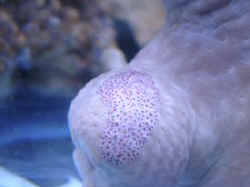
|
Nasty Snail Tale Hi, <Hi there, Scott F. here today!> I
am writing on behalf of a friend who I don't think realizes just
how frustrated and irritated he is. He has two tanks - both
very beautiful and very well kept...except for those little, tiny,
apparently irritating snails. These tanks are both marine
one of which is primarily for more aggressive fish that cannot
realistically be kept with coral that he would like to keep
alive. The other is a smaller tank (for the time being) used
for the coral. This tank has two coral beauties and many
different types of coral including a brain coral and mushrooms among
others. He recently acquired a couple of new pieces of coral
and tonight while looking at it as I always do, I noticed a couple of
snails. One was a tube snail (pointed end at one end, snail
body at the other) and the other was a spiral-shelled
snail. He then pointed out one of the pieces of coral that
seems to be undergoing bleaching as we speak. He has no
doubt these snails are the root of the problem, but when he has asked
his fish store how to remedy the situation, they recommended a fish
that apparently can either eliminate the snails or eliminate the coral.
<Well, the snails may not be causing "bleaching", as this
is an environmental response. However, some species of snails can be
responsible for munching on polyps. There are a couple of ways to
prevent damage caused by the snails. First, you should quarantine
newly-arrived corals for a period of time, expressly for the purpose of
letting these pests "drop off" from the corals. You can place
them on a egg crate platform, and add some "meaty" food, such
as krill, Mysis, etc. underneath. This will help "bait" the
snails and other pests off of the coral, where they can easily be
removed. The other thing that you could do would be to add certain
fishes, such as hawkfish or some wrasses, to the tank, which enjoy
preying on snails.> He does not like this iffy-ness and so is
plucking these snails as he sees them. However, I am most
concerned as these tanks are a source of great joy except this snail
issue seems to really frustrate him. Please tell me there is
a remedy for this and please then tell me what it is. Of
course, these snails were introduced via live rock he purchased from
that same fish store. He figures that store sees enough
business that those live rocks are turned over before the store sees
the snail problem. I have now spent the last two hours
trying to find a solution and while solutions abound for the freshwater
problem, I have found nothing that says what to do for marine.
<Well, as mentioned above, I'd study those two ideas...Should do
the trick> Ok, done babbling now. Please
help. As a side note, he has mentioned that friends he
shares this interest with have similar problems in their
tanks. Of course, they are purchasing their coral, fish, and
live rocks from the same place. Just to add more, case I haven't
said enough, I know pH, nitrates, phosphates, silicates, and salinity
are where they should be. He, as well as his friends,
vehemently maintain their tanks within appropriate ranges and we are
all Oceanographers and Marine Biologists with a tad bit of awareness of
what marine environments should be like. But no matter how
many Marine Biologists we ask, the answer is unknown as usually,
propagation is desired, not removal. Or so we are finding
when the question is asked. <Well, some types of snails, such as
Strombus, Trochus. Astrea, Turbo, etc. are really helpful at
eliminating nuisance algae. Other snails, such as the "Box"
and Pyramidellid snails, are nasty little guys that damage clams and
snails with their habits> Ok, really done babbling
now. Please help. <Well, I hope that I gave you a couple
of good ideas here. Good luck! Regards, Scott F> Thanx Lori
Melting Xeniids & Flatworms Galore Hi there WWM Crew.
<Hey, Mike G with you tonight> Have been enjoying your site and
links but have run into a couple of problems. To begin, let me give you
the stats on the tank: <I personally thank you for giving me the
stats on your tank. Out of many, many emails I have answered today, you
are the first to provide such information. :-) > SG 1.025
<Fine> pH 8.0 in the morning (before lights come on) and 8.2 5
hours after lights on.. <You might want to find a way to remedy
this. That is a large pH swing, and would cause undue stress to your
pets.> NO2 (0) <Perfect>
NO3 (20) <Okay, but it could be a bit
lower> NH3 (0) <Perfect> Tank is
set up with l MH l4000K and 2 65W 03 actinic along with a Bak Pak 2R
protein skimmer that's skimming l/2 C of green stuff a day. Tank
temp. fluctuates between 77.5 to 80F degrees lately. Water change
weekly 15 gals. Sometimes time doesn't permit, and water gets
changed every 2 weeks. <Sounds fine. I am left wondering how large
your tank is, though.> Problem l: For some reason, my pulsing xenias
are dying (melting) and I can't figure out why. Have had these
Xenias now for almost 2 years pulsing and dividing away and
now... What's going on here? <This is a common problem
with Xeniid corals, they seem to "melt" when in unfavorable
conditions or after drastic changes in water parameters. Take a gander
at the following link, namely the topic "Xenia Health" about
3/4 down the page. http://www.wetwebmedia.com/xeniidfaqs3.htm
> Problem 2: My frog spawn frag (originally only 2 heads - now 6
heads) has been invaded with oval shaped pumpkin colored flatworms -
have no idea where they came from as I do quarantine any and all going
into the main tank. I've read that they come and go But, now
they've migrated to my pagoda coral and I really don't want it
to take over the whole tank (60 gal)! <Ah, there we go, 60
gallons. Flatworms have a habit of overrunning marine aquaria.> On
my next water change or sooner, can I do a fresh water dip or
Lugol's iodine dip on these two corals without harming them and
hopefully getting rid of the flatworms? <That is exactly what
I would have recommended you do.> Thank you for your help/advice.
<Best of luck, Mike G>
|
|

